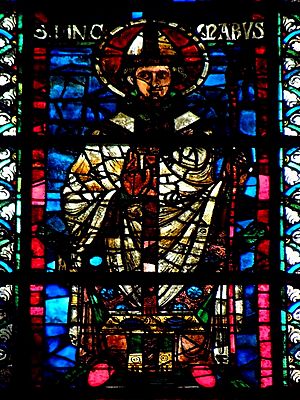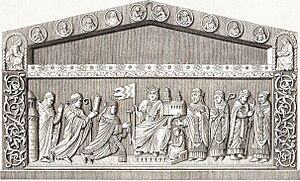Hincmar facts for kids
Quick facts for kids Hincmar |
|
|---|---|
| Archbishop of Reims | |

Representation of Hincmar on a stained glass window in the Saint-Remi basilica of Reims.
|
|
| Archdiocese | Reims |
| In Office | 845-882 |
| Predecessor | Ebbo |
| Successor | Fulk the Venerable |
| Orders | |
| Ordination | 845 |
| Personal details | |
| Born | 806 |
| Died | 21 December 882 |
| Buried | Basilica of Saint-Remi |
| Sainthood | |
| Feast day | 21 December 5 March |
| Venerated in | Catholic Church (Benedictines) |
| Title as Saint | Archbishop, Monk |
Hincmar (born in 806 – died on December 21, 882) was an important leader in the Christian church. He became the archbishop of Reims in France. Hincmar was also a smart legal expert and a religious thinker. He was a close friend, advisor, and supporter of Charles the Bald, who was a powerful king in the Frankish kingdom. Hincmar came from a well-known noble family in northern France.
Contents
Hincmar's Life Story
Early Years and Education
Hincmar was born in 806 into a respected family in what is now western France. He was meant to become a monk, so he grew up and studied at a famous monastery called Saint-Denis. His teacher was Abbot Hilduin. In 822, Hilduin became a chaplain (a religious advisor) at the court of Emperor Louis the Pious. Hincmar went with him and learned a lot about how the empire was run, both in government and in the church.
In 830, Hilduin got into trouble and was sent away. Hincmar went with him to Corvey in Germany. Hincmar used his good standing with Emperor Louis to help Hilduin. He was very loyal to the emperor and helped him during his struggles with his own sons.
Serving King Charles the Bald (840–877)
After Emperor Louis the Pious died in 840, Hincmar supported Charles the Bald. Charles later gave Hincmar control over two important monasteries: Nôtre-Dame at Compiègne and Saint-Germer-de-Fly.
Becoming Archbishop of Reims (845)
The previous archbishop of Reims, Ebbo, had been removed from his position in 835. This happened because he broke his promise of loyalty to Emperor Louis. After Louis died, Ebbo tried to get his position back for a few years. But in 844, Pope Sergius II confirmed that Ebbo was still removed.
In 845, with the king's help, Hincmar became the new archbishop of Reims. This decision was approved at a church meeting (Synod) in Beauvais. He officially became archbishop on May 3, 845. Two years later, Pope Leo IV sent him the pallium, which is a special woolen scarf that symbolizes his authority as an archbishop.
One of Hincmar's first tasks was to get back church lands that had been given away to other people. He also had a big disagreement with priests who had been ordained (made priests) by Ebbo when Ebbo briefly returned. Hincmar believed these ordinations were not valid. In 853, a church council decided against these priests, and Pope Benedict III agreed in 855.
For the next 30 years, Hincmar was a very important figure in both the church and the government. He was a strong leader who greatly influenced the policies of the West Frankish kingdom. He worked hard to protect and expand the rights of the church, especially his own church in Reims. He was very knowledgeable about church law, but he sometimes bent the rules to suit his own interests.
Disputes Over Beliefs
Hincmar's first major challenge was with a theologian named Gottschalk. Gottschalk taught ideas about "predestination," which is the belief that God has already decided everything that will happen, including who will be saved. Hincmar believed these ideas were wrong and dangerous. He managed to have Gottschalk arrested and imprisoned in 849.
Even though Gottschalk was imprisoned, some people defended his ideas. But Hincmar worked hard to make sure Gottschalk's theories were officially condemned at church councils in 853 and 855. Hincmar also wrote books to argue against Gottschalk's ideas. Gottschalk died in prison in 868.
The Divorce of King Lothair II
Hincmar also got involved in the divorce of Lothair II, who was the king of Lorraine. King Lothair wanted to divorce his wife, Theutberga, to marry another woman. In 860, Hincmar wrote a strong paper against the king's divorce, arguing that it was wrong both morally and legally.
Hincmar strongly supported King Charles the Bald's plans for Lorraine. He wanted the entire church area of Reims to be under one friendly ruler. In 869, Hincmar himself crowned Charles as the king of Lorraine.
Conflicts with Other Bishops
Around the mid-800s, a collection of fake church documents, known as the Pseudo-Isidorian Decretals, appeared in France. These documents made bishops and local church councils seem more important, and they also gave the Pope more direct power. This reduced the power of archbishops like Hincmar.
Rothad, bishop of Soissons, was a bishop who supported these new fake documents. He quickly clashed with Hincmar, his archbishop. In 863, Hincmar had Rothad removed from his position. But Rothad appealed to Rome, and Pope Nicholas I strongly supported him. In 865, the Pope ordered that Rothad be put back in his position, even though Hincmar protested.
Hincmar faced another setback when he tried to stop Wulfad, one of the priests Ebbo had ordained, from becoming the archbishop of Bourges. King Charles the Bald supported Wulfad. After another church meeting, Pope Nicholas I sided with the priests Ebbo had ordained, and Hincmar had to accept the decision in 866.
Hincmar had more success in his conflict with his own nephew, also named Hincmar, bishop of Laon. His nephew refused to accept his uncle's authority as archbishop. Hincmar wrote a book explaining his nephew's mistakes and had him removed from his position at a church council in 871. The bishop of Laon was sent away and faced harsh consequences. Pope Adrian II protested this, but the removal was confirmed by Pope John VIII in 876. It wasn't until 878 that the nephew was allowed back into the church.
A serious conflict happened in 876 between Archbishop Hincmar, King Charles, and the Pope. Pope John VIII, at the king's request, gave Ansegisus, archbishop of Sens, special authority over all of France and Germany, making him a "vicar apostolic" (a special representative of the Pope). Hincmar saw this as taking away the power of archbishops. He wrote a book arguing against this new authority. However, King Charles the Bald supported Ansegisus.
Later Years (877–882)
Even though Hincmar had not liked King Charles's trip to Italy, he was one of the people chosen to carry out Charles's will. He helped the nobles accept Louis the Stammerer as the new king, and Hincmar crowned Louis in 877. During Louis's reign, Hincmar played a less public role. He supported the next kings, Louis III and Carloman, but he had a disagreement with Louis III about choosing a bishop for Beauvais.
When Carloman became king in 882, Hincmar wrote a book called De ordine palatii. This book explained his ideas about how a king should govern and what a ruler's duties were. He had written about this topic before in other works dedicated to Charles the Bald and Louis the Stammerer. In the autumn of 882, Viking raiders (Normans) forced the old archbishop to flee to Épernay, where he died on December 21, 882.
Hincmar's Writings
Hincmar wrote many books and letters. Besides the works already mentioned, he wrote several religious papers. He also wrote about claiming back church land. From 861, he continued writing the Annales Bertiniani, which is a very important historical record of the time of Charles the Bald. Many of his letters still exist today, and some are included in other historical writings.
Hincmar's writings are the main source of information about his life. They were collected and published by different scholars over the centuries.
Hincmar might also be the author of an anonymous book called Gesta Dagoberti, which is a biography of an earlier king, Dagobert I.
In one of his letters, Hincmar suggested that new bishops should be given a copy of Gregory the Great's book called Pastoral Care along with the Book of Canons (church laws) when they are consecrated.
Veneration
Hincmar is honored in the Catholic Church:
- December 21 is his main feast day, marking the anniversary of his death.
- March 5 is a day of remembrance for him in the Benedictine Order calendar.
See also
 In Spanish: Hincmaro de Reims para niños
In Spanish: Hincmaro de Reims para niños


